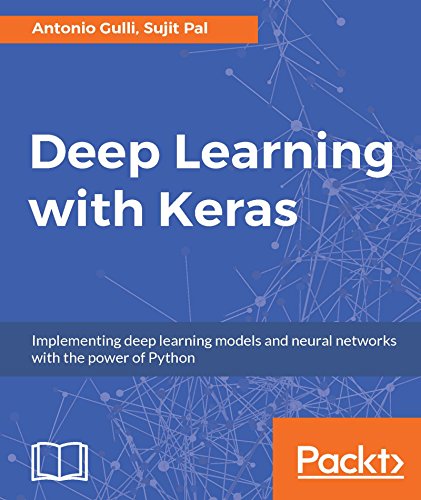--
Deep Learning with Keras
我比较推荐这本书作为参考资料:

同时下列链接也是常用的:
Keras document
Keras 中文文档
Keras 在后台使用 tensorflow 或者 theano 框架,是一种更加高层次的深度学习框架,
可以很容易搭建一个神经网络(当然如果你需要更加定制化以及精细的控制的话,可能 Keras 不一定够了)
1. 利用 Keras 对 MNIST 手写数字识别
Keras MNIST
'''Trains a simple convnet on the MNIST dataset.
Gets to 99.25% test accuracy after 12 epochs
(there is still a lot of margin for parameter tuning).
16 seconds per epoch on a GRID K520 GPU.
'''
from __future__ import print_function
import keras
from keras.datasets import mnist
from keras.models import Sequential
from keras.layers import Dense, Dropout, Flatten
from keras.layers import Conv2D, MaxPooling2D
from keras import backend as K
batch_size = 128
num_classes = 10
epochs = 12
# input image dimensions
img_rows, img_cols = 28, 28
# the data, split between train and test sets
(x_train, y_train), (x_test, y_test) = mnist.load_data()
if K.image_data_format() == 'channels_first':
x_train = x_train.reshape(x_train.shape[0], 1, img_rows, img_cols)
x_test = x_test.reshape(x_test.shape[0], 1, img_rows, img_cols)
input_shape = (1, img_rows, img_cols)
else:
x_train = x_train.reshape(x_train.shape[0], img_rows, img_cols, 1)
x_test = x_test.reshape(x_test.shape[0], img_rows, img_cols, 1)
input_shape = (img_rows, img_cols, 1)
x_train = x_train.astype('float32')
x_test = x_test.astype('float32')
x_train /= 255
x_test /= 255
print('x_train shape:', x_train.shape)
print(x_train.shape[0], 'train samples')
print(x_test.shape[0], 'test samples')
# convert class vectors to binary class matrices
y_train = keras.utils.to_categorical(y_train, num_classes)
y_test = keras.utils.to_categorical(y_test, num_classes)
model = Sequential()
model.add(Conv2D(32, kernel_size=(3, 3),
activation='relu',
input_shape=input_shape))
model.add(Conv2D(64, (3, 3), activation='relu'))
model.add(MaxPooling2D(pool_size=(2, 2)))
model.add(Dropout(0.25))
model.add(Flatten())
model.add(Dense(128, activation='relu'))
model.add(Dropout(0.5))
model.add(Dense(num_classes, activation='softmax'))
model.compile(loss=keras.losses.categorical_crossentropy,
optimizer=keras.optimizers.Adadelta(),
metrics=['accuracy'])
model.fit(x_train, y_train,
batch_size=batch_size,
epochs=epochs,
verbose=1,
validation_data=(x_test, y_test))
score = model.evaluate(x_test, y_test, verbose=0)
print('Test loss:', score[0])
print('Test accuracy:', score[1])
可以看到 Keras 的神经网络搭建真的非常简单,完全就像搭建积木一样
利用 model.add() 按照 sequence 的顺序,一层又一层, 这个 Sequence 的 model 又提供了接口 fit(), evaluate(), compile() 就像 sklearn 一样。
Keras 提供了各种不同类型的 layer,包括: Dense, Activation, Flatten,Conv2D 等等。 比较关心的是 Conv2D():
keras.layers.Conv2D(
filters, kernel_size, strides=(1, 1),
padding='valid', data_format=None,
dilation_rate=(1, 1),
activation=None, use_bias=True,
kernel_initializer = 'glorot_uniform',
bias_initializer = 'zeros',
kernel_regularizer = None,
bias_regularizer=None,
activity_regularizer = None,
kernel_constraint = None,
bias_constraint=None)
基本上这些参数是很好理解的。
filters: 输出层的层数
kernel_size: 卷积核的大小,比如 (3, 3)
strides: 滑动步长
activation: 默认没有 activation,也可以是 'relu' 或者 'sigmoid','tanh' 等等
padding = 'same':
padding means the size of output feature-maps are the same as the input feature-maps (under the assumption of stride=1).
For instance, if input is nin channels with feature-maps of size 28×28, then in the output you expect to get nout feature maps each of size 28×28 as well.
padding = 'valid':
no padding